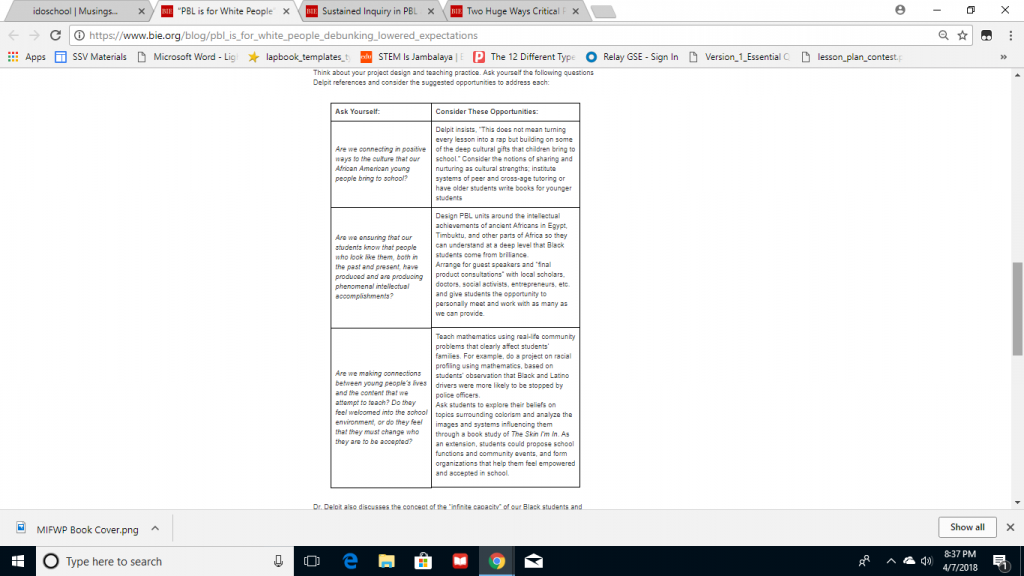“PBL is for White People”: Debunking Lowered Expectations
Nov 1, 2017 by Charity Parsons, Ed.S.

Originally published on www.bie.org on October 28, 2017
As a member of the Buck Institute for Education’s National Faculty, I am honored to know that one of BIE’s core beliefs speaks to the reasons why we are committed to our vision. Of the five pillar belief statements, this one stands out as my favorite:
“PBL advances educational equity and empowers youth furthest from opportunity.”
When leveraged appropriately, Gold Standard PBL (GSPBL) can help reduce achievement disparities and empower ALL stakeholders to become lifelong learners, including and often especially Black males. I’ve witnessed this in my own classroom as well as classrooms, schools, and districts across this grand nation!
The role of deeper learning methods in educational equity has been the topic of much discussion. In December 2016, Sam Seidel’s Deeper Learning Has a Race Problem – And It May Have the Solution replied to a 2014 post by Jal Mehta, highlighting considerations for educators as we talk about how all students can access deeper learning experiences. Seidel suggests that instead of looking at racial disparities in academic success as unfortunate “achievement gaps,” educators should acknowledge that in many cases, due to structural racism, students of color are not receiving the same opportunities as white students and work proactively to address this.
Dr. Lisa Delpit dives deeper into the ideas surrounding educational equity and the instructional strategies proven to empower Black males in Multiplication is for White People: Raising Expectations for Other People’s Children. Opening with a poignant reminder that there is no achievement gap at birth, Delpit points to negative typecasts, lowered expectations, and a curriculum that does little to connect to the lives of children of color and those furthest from opportunity – especially Black males. She offers empirical and anecdotal examples of practices proven to empower, engage, and educate children of color, from elementary classrooms to the college years.
Delpit exposes multiple examples of persistent beliefs that “these kids” are not capable of aspects of advanced, deeper methods of learning. And Black students have absorbed the message of lower expectations of their classrooms and school. (No spoiler alert here, I’ll leave it for you to discover the story that led to the book’s title.) What is of most importance to our discussion are the solutions: Dr. Delpit examines the data and proposes solutions to the issue of expectations that plague teachers of children of color.
The PBL-Delpit Connection
I dare to extend the same solutions to ALL children furthest from opportunity!
Unpacking the solutions proposed by Dr. Delpit, I was amazed at how BIE’s Gold Standard PBL Project Design Elements and Project Based Teaching Practices correlate in a radically elegant way, further evidencing PBL’s ability to foster educational equity:
Designing Projects that Connect with Students
Think about your project design and teaching practice. Ask yourself the following questions Delpit references and consider the suggested opportunities to address each:

Dr. Delpit also discusses the concept of the “infinite capacity” of our Black students and other students furthest from opportunity, referring to the unlimited potential of ALL students. While mapping out the standards, content, and skills to be addressed in new project ideas, I ask teachers directly how they intend to tap into their students’ infinite capacity. Together, we explore ways to connect students to their immediate community and their cultural legacy; THEN we design PBL units accordingly.
As stated by the Harvard Educational Review of Multiplication is for White People, “ultimately, the quality of education that Delpit advocates for Black children is a high but necessary bar, one that all children need and deserve”. I avow the same for PBL – all students, ESPECIALLY those furthest from opportunity, deserve the learning experience of a Gold Standard PBL classroom.
What do you think about Dr. Delpit’s work and how it connects to GSPBL? What are some ways you tap into your students’ infinite capacity? I’d love to continue the conversation! Tweet me @iDoSchool and let’s talk about it!
As a member of the Buck Institute for Education’s National Faculty, I am honored to know that one of BIE’s core beliefs speaks to the reasons why we are committed to our vision. Of the five pillar belief statements, this one stands out as my favorite:
“PBL advances educational equity and empowers youth furthest from opportunity.”
When leveraged appropriately, Gold Standard PBL (GSPBL) can help reduce achievement disparities and empower ALL stakeholders to become lifelong learners, including and often especially Black males. I’ve witnessed this in my own classroom as well as classrooms, schools, and districts across this grand nation!
The role of deeper learning methods in educational equity has been the topic of much discussion. In December 2016, Sam Seidel’s Deeper Learning Has a Race Problem – And It May Have the Solution replied to a 2014 post by Jal Mehta, highlighting considerations for educators as we talk about how all students can access deeper learning experiences. Seidel suggests that instead of looking at racial disparities in academic success as unfortunate “achievement gaps,” educators should acknowledge that in many cases, due to structural racism, students of color are not receiving the same opportunities as white students and work proactively to address this.
Dr. Lisa Delpit dives deeper into the ideas surrounding educational equity and the instructional strategies proven to empower Black males in Multiplication is for White People: Raising Expectations for Other People’s Children. Opening with a poignant reminder that there is no achievement gap at birth, Delpit points to negative typecasts, lowered expectations, and a curriculum that does little to connect to the lives of children of color and those furthest from opportunity – especially Black males. She offers empirical and anecdotal examples of practices proven to empower, engage, and educate children of color, from elementary classrooms to the college years.
Delpit exposes multiple examples of persistent beliefs that “these kids” are not capable of aspects of advanced, deeper methods of learning. And Black students have absorbed the message of lower expectations of their classrooms and school. (No spoiler alert here, I’ll leave it for you to discover the story that led to the book’s title.) What is of most importance to our discussion are the solutions: Dr. Delpit examines the data and proposes solutions to the issue of expectations that plague teachers of children of color.
The PBL-Delpit Connection
I dare to extend the same solutions to ALL children furthest from opportunity!
Unpacking the solutions proposed by Dr. Delpit, I was amazed at how BIE’s Gold Standard PBL Project Design Elements and Project Based Teaching Practices correlate in a radically elegant way, further evidencing PBL’s ability to foster educational equity:
- Constant, rigorous, integrated across disciplines: In PBL, educators design learning experiences that are challenging, align to standards, and incorporate relevant interdisciplinary connections. (Think: Key Knowledge, Understanding, & Success Skills; Design & Plan; Align to Standards)
- Connected to students’ lived cultures and to their intellectual legacies:
Envision a school in which students’ personal concerns, interests, and issues in their lives are integral components of high quality PBL units. Such schools leverage students’ lives and link them to authentic public audiences in their community. This builds a school culture that proves attentive to the gifts, talents, and resources that students bring to the table. (Think: Authenticity; Reflection; Public Product; Build the Culture) - Designed for critical thinking and problem solving that is useful beyond the classroom: As the designers of authentic projects, we can ask students to apply their learning beyond the classroom, including calls to action, philosophical explorations, or the creation of products for specific purposes and audiences. In each of these tasks, skills such as critical thinking/problem solving, communication, collaboration, and self-management are explicitly introduced to students and they are given multiple opportunities to practice, reflect upon, and refine these skills. (Think: Authenticity; Success Skills; Build the Culture)
Designing Projects that Connect with Students
Think about your project design and teaching practice. Ask yourself the following questions Delpit references and consider the suggested opportunities to address each:

Dr. Delpit also discusses the concept of the “infinite capacity” of our Black students and other students furthest from opportunity, referring to the unlimited potential of ALL students. While mapping out the standards, content, and skills to be addressed in new project ideas, I ask teachers directly how they intend to tap into their students’ infinite capacity. Together, we explore ways to connect students to their immediate community and their cultural legacy; THEN we design PBL units accordingly.
As stated by the Harvard Educational Review of Multiplication is for White People, “ultimately, the quality of education that Delpit advocates for Black children is a high but necessary bar, one that all children need and deserve”. I avow the same for PBL – all students, ESPECIALLY those furthest from opportunity, deserve the learning experience of a Gold Standard PBL classroom.
What do you think about Dr. Delpit’s work and how it connects to GSPBL? What are some ways you tap into your students’ infinite capacity? I’d love to continue the conversation! Tweet me @iDoSchool and let’s talk about it!

